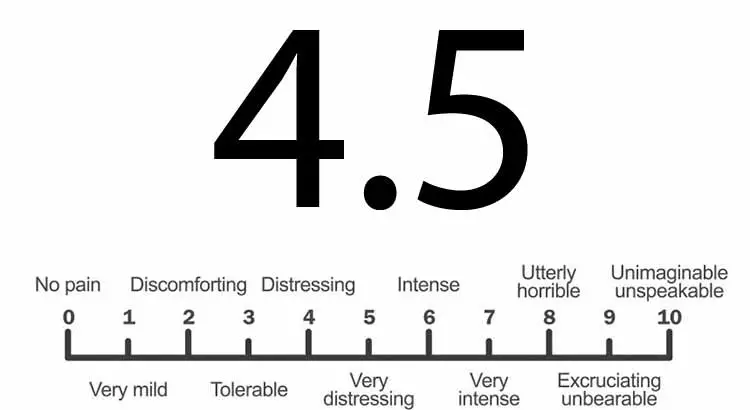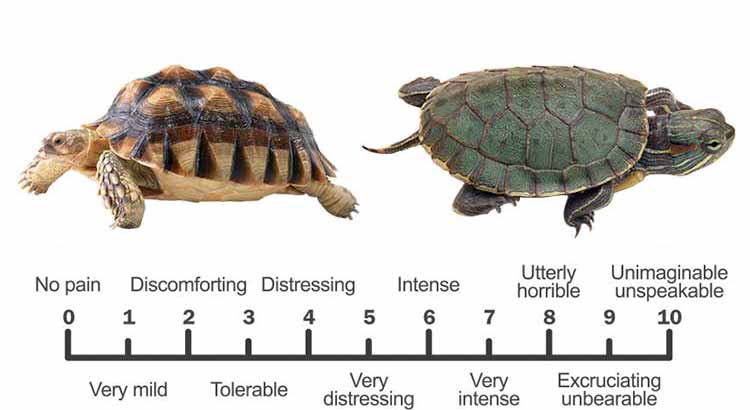Whether you found a turtle in the middle of the road and you are thinking of picking it up or you want to get a pet turtle, this article will tell you everything you need to know about turtle bites.
How much a turtle bite will hurt you depends on the size and species of the turtle. If the turtle is small and doesn’t have a sharp beak, the bite won’t leave any marks and the pain will be mild. But if the turtle is big and it has a sharp beak, the pain can be very intense and it might leave a few signs.
In order to make sure that I will give the most accurate description of how a turtle bite feels, I let a few of my turtles bite me. So let me tell you how those bites felt, and what turtles they were.
How It Feels to Get Bitten by a Turtle
To write this article I let three different turtles bite my finger, as this is the most common place people get bitten. The turtles were:
- A 6.5 inches Hermann tortoise, which is a herbivore (eats only plants)
- A 10 Inches Red Eared Slider, which is omnivorous (eats plants and meat)
- A 6 inches Box Turtle, which is omnivorous (eats plants and meat)
Turtles don’t bite people if they don’t have a good reason, so in order to get them to bite me, I camouflaged my finger with some salad, which was scaringly efficient.
Being a herbivore the Hermann tortoise doesn’t have a sharp beak so I started the experiment with her. The bite itself wasn’t that bad, on a scale from 1 to 10 I would say it was a 3. The most similar thing that comes to mind is the pain that you feel when you catch your finger in a drawer, you can definitely feel the pain, but in 5 minutes it’s like it never happened.

The bite of the Box turtle was a little worse. While the turtle itself is slightly smaller, the fact that it’s an omnivore, and not a herbivore means that its beak is slightly sharper as it’s meant to rip meat pieces. ( Turtles don’t have teeth, instead, they have beaks, if you want to know more about this you can read my dedicated article right here: Do Turtles Have Teeth? (with Pictures and Video) ).
On a scale from 1 to 10, I would say that this was a 4. So to use the same drawer example, it’s like somebody used some force to close the drawer, and it caught your finger right with the edge. The pain might disappear in 5 or 10 minutes but most definitely you will end up with a swollen finger for a few hours.

In the case of the Red Eared Slider, I have to admit that I almost backed down, but in the end, I decided to do it. And to my surprise it wasn’t as bad as I expected it to be, don’t get me wrong it was worse than the Box turtle but not as bad as I was expecting. On the scale, I would rate it as a 4.5. There was a little more force behind the bite but not as bad as I was expecting.

One very important thing to keep in mind is that my turtles bit me due to a mistake, they thought they were biting into lettuce. So as soon as they realized that they bit me they let go immediately. If a turtle were to bite you intentionally it won’t let you go. So let’s discuss in which situations a turtle will bite you, what to do if you are bitten, and more importantly what not to do.
When Can a Turtle Bite You
When a Turtle Feels It’s in Danger
If a turtle feels that it’s in danger, and there is no way for it to escape, it will think that there is no other option than to attack before it’s attacked, so it will try to bite you.
In general, a turtle will not be the first one to initiate any kind of interaction, ( you can find out why in this article: Are Turtles Social or Solitary Animals? (with Pictures and Video) ), this means that they won’t think of biting you as soon as they see you, they will only do this if they think they have no other option.
What kind of behavior will make a turtle think you want to attack is variable, but in general sudden moves and approaching too quickly are seen as aggressive behavior.
If you find a turtle in the middle of the road and you want to move it, you can safely do so, without risking getting bitten, by grabbing it by the sides of the shell, where it shouldn’t be able to reach with its head, or legs. If you have some gloves or a spare t-shirt that you can wrap around your hands it will be even better. But if you ever find yourself in this situation you should check out this article: What Do You Do if You Find a Turtle (+ Biggest Mistakes), as there are quite a few dangerous mistakes that you could make
When handling a pet turtle you should use the same method and grab it by the sides of the shell. Pet turtles are supposed to be used to humans, so unless you handle them aggressively they shouldn’t want to bite you.
When a Turtle Mistakes You for Food
A turtle is generally able to tell the difference between a human and a small piece of meat or a vegetable, but under certain circumstances, they can easily mistake one of your fingers or toes for something that kind of resembles something that they would normally eat.
At this point, you have to remember that turtles and tortoises are opportunistic feeders, regardless if they are pets or wild, so when they see something that they think that they could eat, they will jump and bite it without hesitation.
A turtle can also bite you if you try to feed it with your hand, they usually do this by mistake, sometimes they can mistake one of your fingers for food, or they can just simply bite it without intent.
From my personal experience, if you want to avoid having your turtle mistake your toes or fingers for food, you should never walk without shoes around them, especially if there is tall grass in the area, and you should avoid feeding them directly with your hand.
What to Do if You Are Bitten by a Turtle
In the case of a small, harmless bite, like the ones from my turtles, there isn’t much that you have to do. Just make sure that you wash your hands before you do anything else. And try to leave the turtle alone for a while, as I said they usually bite because they are stressed, they feel in danger, or they thought they were eating food, no matter why they bite you they will feel a little agitated for a while, so it’s better to leave them alone.
If you see any blood you should drop everything that you were doing and go disinfect the wound, even if the wound is small it can still get infected, and that can be very dangerous. I would also recommend going to the doctor after you have disinfected it. A doctor will be able to tell you if any further treatment for the wound is needed.
If the turtle bites you and doesn’t want to let go, you have to wait until it releases the bite. Doing anything else will only worsen the situation. It might seem counterintuitive but it’s the best way to act in this situation. If after a minute it still won’t let go, then you should pour some water on it, but do so very carefully.
What Not to Do if You Are Bitten by a Turtle
If a turtle bites you and doesn’t want to let go, you don’t want to pull or hit the turtle. If you hit the turtle it will only apply more pressure to the bite, and it will stay there for longer. If you hit the turtle until it goes unconscious things will only get worse for you, because at that point the jaws are going to apply even more pressure, and the turtle won’t be able to release it. And in this process, your wounds are only going to get worse. So as I said, even if it seems counterintuitive, the best thing to do is to peacefully wait until the turtle releases the bite.
After a turtle bites you you have to be very careful what you do with your hands, do not put them near your face, or near food. Turtles can carry a lot of germs and sometimes even bacteria, and spreading them is not a good idea. Instead, go and wash your hands as soon as possible.
If a turtle bites you because it’s stressed, don’t stress it anymore. Just leave the area and leave it alone. If the turtle that bit you is your pet turtle, you should let it rest peacefully for some time and come back again later, if you have any business with the turtle. A couple of hours should be enough time for the turtle to calm down.
It’s good to know what to do and what not to do if you get bitten, but even better is to know how to avoid it, so let’s talk about that.
How to Avoid Getting Bitten
The best way to protect your fingers is to keep them away, so don’t feed your turtle with your hand, you can just place the food on the ground. Turtles don’t care how they get their food as long as they get it.
If you want to protect your toes then you should hide them, so don’t wear slippers or any kind of footwear that will keep them visible.
If you own a turtle and you don’t want to get bitten then you should make sure that it’s well fed. If a turtle is hungry it will try to eat anything that looks remotely similar to food.
Don’t stress out turtles, even if they are peaceful by their nature, they will still attack you if they are stressed out and they feel in danger.
If a wild turtle seems very agitated you should try to keep your distance, it can always bite you if you get too close.
And always try to handle them with care. If you properly handle a turtle there is no chance that you will get bitten, so avoid placing your hand anywhere close to its head.
Final Thoughts
In the end, I want to tell you that even if I let my turtles bite me, you shouldn’t repeat the experiment at home. The reason why I was confident in doing this I because over the years (especially when I didn’t know any better) my turtles have bitten me a few times and I knew that they will let go immediately, but not all turtles the same, so it’s not a certain thing that your turtle will let go immediately.
Turtle bites hurt, but they aren’t so bad. You definitely want to avoid them, but getting bitten by your pet turtle is not that bad. But if a wild turtle bites you things might get a little more complicated, as they have a lot more germs and bacterias.
And remember, when you handle a turtle, whether it’s your pet or a wild one, grab it by the sides of the shell, and stay away from its head.


